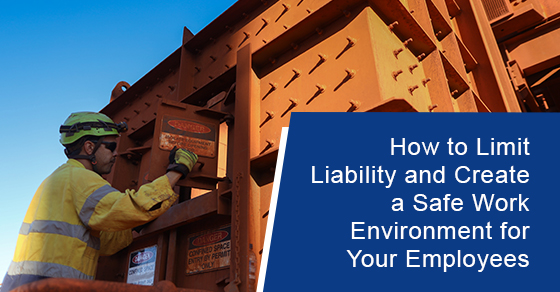
How to Limit Liability and Create a Safe Work Environment for Your Employees
Posted by on Apr 20, 2022 in
As a small business owner, you have to take on multiple roles to keep your business running. There is never a shortage of items on your to-do list, from marketing and accounting to restocking and cleaning. With so many things going on at once, it can be easy to overlook your most valuable asset: your employees. Creating a safe work environment is key to preventing employee injuries resulting in expensive compensation claims. On top of that, you may also incur some indirect costs, including:
- Lost in production time
- Time in hiring and training a new employee
- Any property damage
- Decreased morale in the workplace
Conduct a Hazard Assessment
Every workplace has its unique hazards. You will be better positioned to control or remove them and prevent dangerous accidents by correctly identifying them. To start, gather a team to conduct a workplace inspection. Ideally, this should include a manager, a floor supervisor, an employee with knowledge of daily processes and procedures, and an employee in the workplace committee. Depending on the equipment and technical requirements, you may need an expert on the team, for example, an electrician or a mechanic. The goal of the inspection is to look for any existing or potential hazards in the environment. Types of risks can include:- Physical hazards: noise, weather, heat, cold, electricity, radiation
- Safety hazards: machines, unsafe work practices, slippery floors, tripping hazards
- Biological threats: viruses, bacteria
- Chemical hazards: gas, dust, fume, vapour
- Ergonomic hazards: repetitive movement, poor posture, poorly-designed workstations
- Psychosocial risks: overworking, stress, bullying
- Any legislative requirements
- Any past incidents or accidents
- Size of operations
- Types of work processes involved
- Types of machines involved
Create an Action Plan
Now that you have identified the hazards in your workplace, it’s time to create an action plan. First, prioritize the identified risks. Which is most likely to cause an injury? Which hazards should you address immediately? Then, you can make a solution plan for controlling or eliminating these hazards. Keep in mind that specific issues may require the expertise of others, such as an electrician, an industrial hygienist, or a mechanic. Here are some examples of common workplace hazards and how you may eliminate or control them:Wet or Slippery Floors
Ensure all spills in the hallways and common areas are immediately cleaned. Shovel and salt all walkways outside the workplace after snowfalls in the winter.Heavy Lifting
If workers are required to manually handle or lift heavy items regularly, ensure a safe system for accessing things that are hard to reach. You should also place heavier items on lower shelves in a cabinet or shelving system.Repetitive Strain Injuries
While office workers are less likely to be injured from an accident, they are at risk for chronic injuries such as neck and back pain, carpal tunnel, and vision issues. Ergonomic office equipment, such as adjustable computer chairs and desks, can help ensure proper posture and improve the health of office employees.Fire Hazards
Create a fire evacuation plan and ensure all staff members know the necessary steps in the event of a fire. Ensure that fire doors and hallways remain clutter-free and train staff on how to use fire extinguishers.Train Your Employees
Now, it’s time to put the action plan in place and train your employees on the new workplace health and safety plan. Training may involve walking them through potential hazards in the workplace and demonstrating how they can prevent or mitigate them. Make sure to keep a record of this training as it may reduce your liability in case of an accident.Follow Up
To ensure that the inspection process is meaningful and effective, a member of the workplace committee should manage the action plan and ensure that employees implement the suggested corrective measures. You should also encourage workers to provide timely feedback so that you may continue to improve the work environment.Get Small Business Insurance
A workplace health and safety plan can help reduce the chances of employee injury. However, accidents can still happen. With the right small business insurance policy, you can protect yourself and your business from losses due to unforeseen events. Some of the most common coverage available to small businesses include:- General liability insurance: to protect you if someone, including a client or outsider, gets injured on your property
- Worker’s compensation insurance: to provide coverage if an employee gets injured on the job
- Property coverage: to protect your business facility
- Business interruption coverage: to replace the loss of income due to shut downs caused by an insured loss

